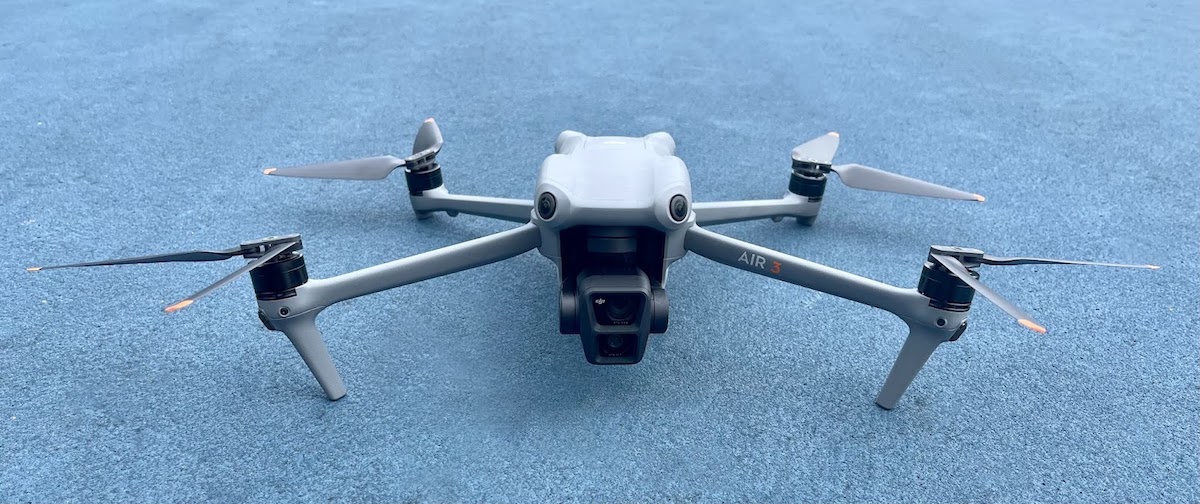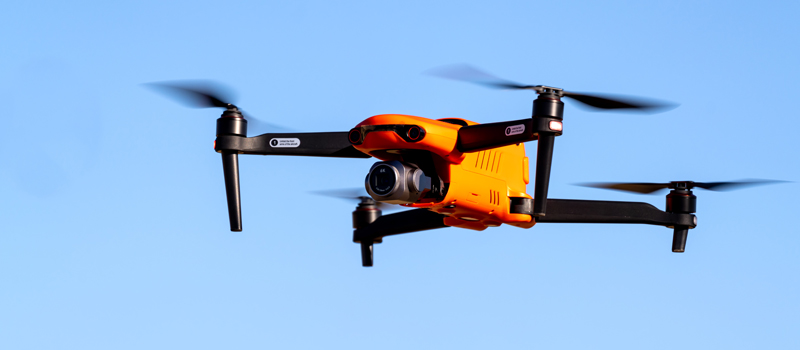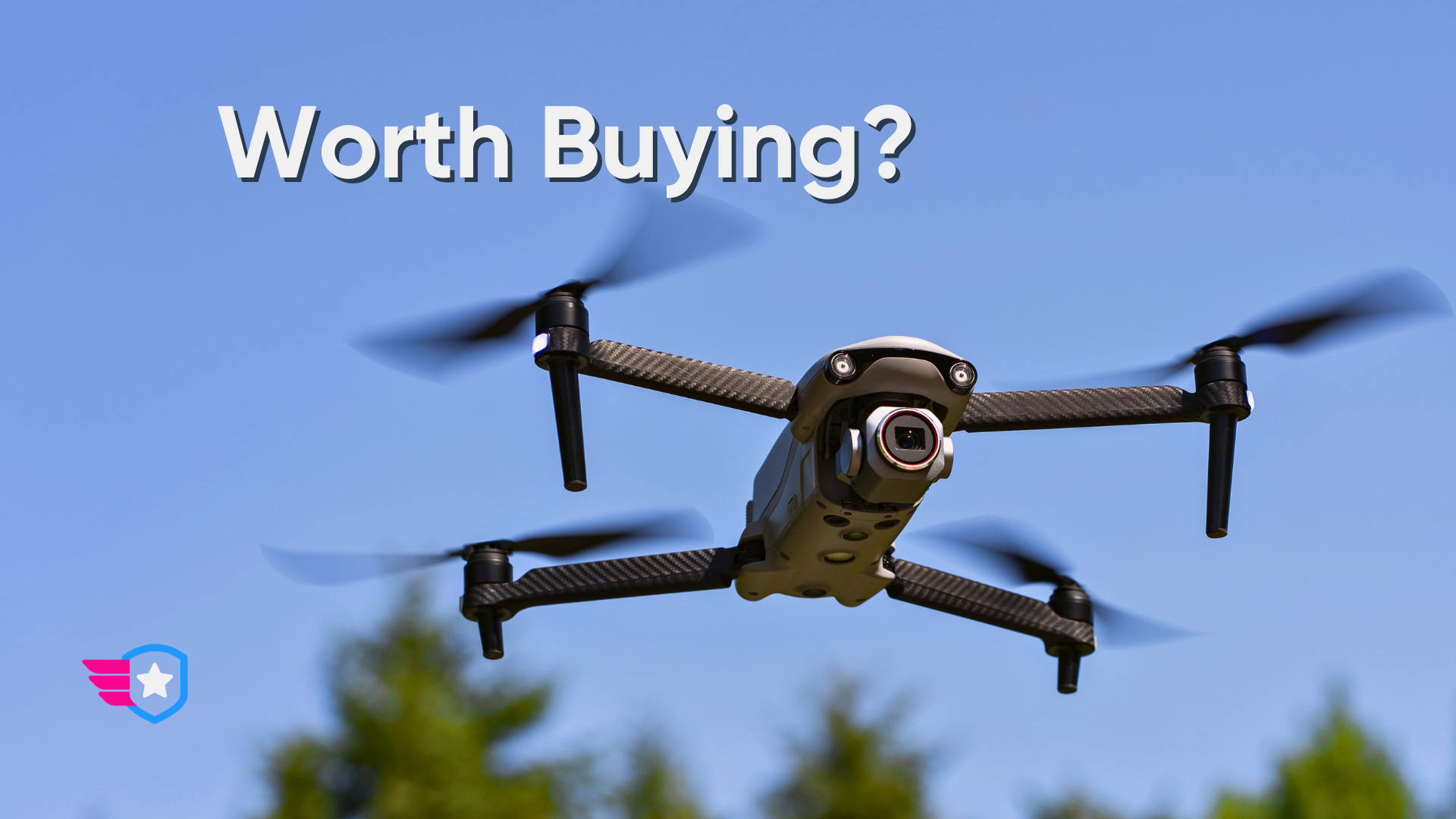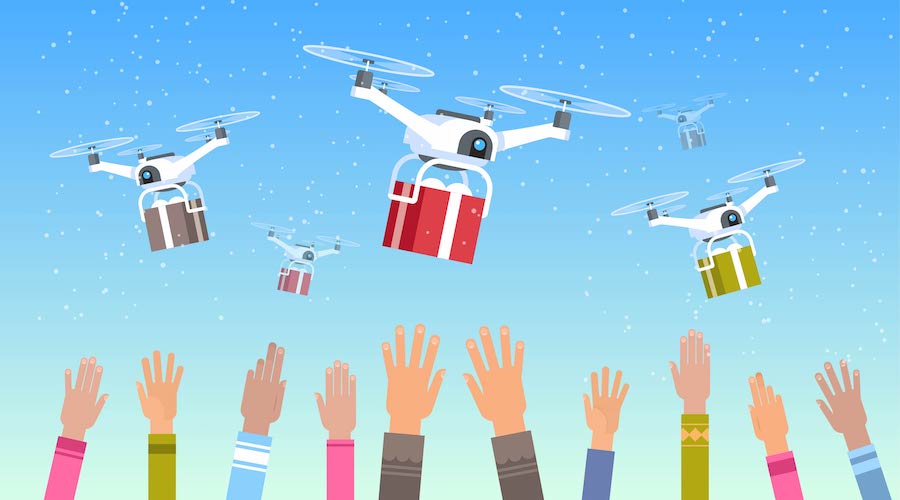DJI released the Air 2S in April 2020. It ditched the naming convention of its predecessor, the Mavic Air 2, and features a 20MP 1″-type sensor – previously exclusive to DJI-brand drones retailing for over $1,500. The Air 2S is able to capture 5.4K video compared to the Mavic Air 2’s 4K and it contains an extra pair of obstacle avoidance sensors on top.
In November 2021, DJI released the Mavic 3 series featuring a dual-camera system with a 20MP Four Thirds CMOS sensor on the main camera, up to 46 minutes of battery life, and omnidirectional obstacle avoidance. It also came with a hefty price tag. At close to $3,000, it’s nearly twice as much as its predecessor, the Mavic 2 Pro. Even with the introduction of the more affordable Mavic 3 Classic a year on, it was clear that while the Mavic 3 series, in general, was an ideal solution for prosumers, it was still out of reach for many remote pilots – especially enthusiasts.
The Air 3 fills the gap between the Air 2S, as an upgrade, and the Mavic 3 series as a more affordable option. Outfitted with DJI’s latest O4 transmission system, this model is longer and thinner both in body and propellers. There are fisheye lenses on the front and sides of the aircraft for omnidirecational detection and avoidance. The Air 3 can stay in the air for up to 46 minutes. Its dual-camera system contains two Type 1/1.3 sensors, can capture 48MP photos, and up to 4K/60p video.
The Air 3 can capture 48MP photos with a 3X zoom (pictured above).
Two new remotes have been introduced with the Air 3. The RC-N2 is an upgrade from the RC-N1, which requires an attached smartphone to operate the drone, while the RC 2 improves upon the RC 1 and features built-in and exterior antennas. This means you’ll also have to invest in a new remote as former models are not compatible. The RC Pro remote will not work with the Air 3 either.
So, the question is, is it worth the investment if you’re looking to upgrade from an Air 2S or Mavic Air 2? Is this a viable option if you can’t justify the cost of a Mavic 3 Pro? Let’s find out.
Comparison
The Air 3 falls in between the Air 2S and Mavic 3 series. Because there are so many models to choose from in the latter, we’re going to evaluate how far the Air 3 has come since the release of the original Mavic Air 2.
All pricing is for the Fly More Combos, which include 3 batteries.
| DJI Air 3 | Air 2S | Mavic Air 2 | |
| Price | $1,349 with RC-N2$1,549 with RC 2 | $1,299 | $789 |
| Camera | Dual-camera, 12MP or 48MP Type 1/1.3 sensor24mm equiv. F2.8 (fixed)70mm, F1.7 (fixed) | 20MP, 1″-type sensor22mm equiv. F2.8 (fixed) | 48MP, 1/2-inch sensor24mm equiv. F2.8 (fixed) |
| Video transmission | OcuSync 4.0 (O4), 6 antennas, 20 km, 1080p | OcuSync 3.0 (O3), 4 antennas, 12 km, 1080p | OcuSync 2.0, dual antenna, 10 km, 1080p |
| Video resolution | 4K/60p | 5.4K/30p, 4K/60p | 4K/60p |
| Video bit-rate | 150 Mbps | 150 Mbps | 120 Mbps |
| Log video | 10-bit D-Log M (10-bit) | 10-bit D-Log, HDR video (10-bit) | HDR video (8-bit) |
| APAS version (Advanced Pilot Assistance System) | APAS 5.0 | APAS 4.0 | APAS 3.0 |
| Obstacle avoidance sensors | Omnidirectional, 360º | Forward, Backward, Downward, Upward | Forward, Backward, Downward |
| Flight time | 46 minutes | 31 minutes | 34 minutes |
| Dimensions | 207×100.5×91.1 mm | 180×97×80 mm | 180x97x84 mm |
| Weight | 720g | 595g | 570g |
The Air 3 aircraft and remote
At 207×100.5×91.1 mm folded down, the Air 3 is longer, wider, and taller than the Air 2S at 180×97×77 mm. Its body shares a lot more similarities with the Mavic 3 series. It can withstand wind speeds up to 27 mph, ascend and descend at 22 mph, and travel at a maximum speed of almost 47 mph in Sport mode. The 4241 mAh Intelligent flight batteries snap into the back of the aircraft in the same manner as the Mavic 3, rather than on top like the Air 2S.
DJI created a charger that is better at securing batteries when charging and can transfer power to one.
DJI created a new charging hub for the Air 3’s batteries, which aren’t compatible with any other model. Each battery slides in and is secured more firmly in place compared to chargers for its other drones. It supports a power accumulation function which means that with the touch of a button, you can automatically transfer the remaining power from the other two batteries to one for a maximum flight time.
The Air 3 weighs 720g, almost 200g more than the Air 2S, but it has a EU C1 rating. For those flying in the European Union plus the other countries outside that have adopted EASA’s rules, including Iceland, this means you can fly in the A1 Open Category and you don’t need to take and pass a lengthy, costly exam. The Air 3 and Mavic 3 Pro both feature 3X zoom capabilities. The latter, however, weighs more than 900g. This makes it more difficult to legally operate the Mavic 3 Pro in certain areas.
The RC 2, on the left, is almost identical to the original DJI RC remote on the right. The difference is found in processing power and transmission range.
DJI sent me the RC 2 Fly More combo. The RC 2 remote has a 5.5-inch screen with 700 nits of brightness. It’s practically identical to the original RC as far as features and functionality are concerned. At 420g, the RC 2 is slightly heavier than the original model (385g). It has 32 GB of internal storage for screen recordings or snapshots from the remote and also can house a microSD memory card.
The real upgrade comes in the form of two built-in and two external antennas. They support a dual-transmitter, quad-receiver system giving the RC 2 twice the number of transmitters and receivers compared to the original RC. An updated processor and DJI’s O4 transmission, offering a range of up to 20km (12 miles) of connectivity between the drone and remote, make the RC 2 a superior remote. It retails for $369, on its own, compared to $309 for the original RC.
The Cameras
The Air 3 features a dual-camera system. The top lens is 70mm with a fixed F2.8 aperture while the bottom is 24mm equiv. with a fixed F1.7 aperture.
The Air 3 is the first drone in the Air series to feature a dual-camera system and support 2.7K vertical shooting (9:16). The bottom main camera has a Type 1/1.3 CMOS 24mm equiv. fixed F1.7 wide-angle lens and 82º FOV. On top is a Type 1/1.3 CMOS 70mm medium tele camera, with a 3X optical zoom, and fixed F2.8 aperture with a 35º FOV. Both cameras offer 2.4μm pixel size and the ability to capture 48MP photos.
I’ve found that if you’re shooting in Pro mode, rather than Auto, you will need to slightly adjust your settings when toggling between cameras to make up for the change in aperture. Both cameras support dual native ISO for up to 4K/60p and 4K/100p HDR video along with an ISO up to 6400. 10-bit D-Log M and 10-bit HLG color modes are supported as well. DJI’s Night Mode, which allows for recording up to 4K/30p footage at an ISO of up to 12800, does not support any D-Log format.
The Air 3 takes decent night photos. The details aren’t as defined, but it’s good enough for most use cases.
The main camera supports 1-3X digital zoom, when capturing video, and 3-9X on the tele camera. I find when it starts passing 4X zoom, however, the picture gets fuzzy. When you switch to a 2.7K resolution, the camera will automatically support vertical orientation. You’ll be able to see exactly what you’re recording as the viewfinder adjusts accordingly.
DJI has also been promoting its free LightCut app. Honestly, there are way too many filters and most of them, including one that features red tulips in the foreground, feel a bit impractical. There are many other apps social creators can take advantage of to achieve more polished and engaging content.
The DJI Fly app and Intelligent Flight modes
The Air 3 is supported by DJI’s Fly app. For anyone purchasing a DJI drone for the first time, Fly brings every major camera feature you need to the forefront. It’s easy to switch between photo, video, hyperlapse, and Intelligent Flight modes. At the bottom, you can access Pro mode and fine-tune your camera settings further.
DJI’s Air 3 is also the first in its series to offer Waypoints. Waypoints is a feature that allows you to pre-plan flights for smoother, more professional-looking footage by selecting different points camera angles ahead of time. The drone will fly your course once you’ve set everything up. You can even save the mission for future flights. Recently, DJI made it easier to establish a waypoint by pressing on the ‘C1’ button on the back of the remote. You’ll also be prompted to take this exact step in the app every time you use the feature.
[Insert 4K/60p video clip]
Spotlight 2.0, ActiveTrack 5.0, and Point of Interest 3.0 are all available on the Air 3. Basically, you select a subject that’s either a car or person and the drone will either track it, follow it or fly a perfect revolution. These features work best when you’re closer to the subject. I attempted to track a car that was 75 feet away and it wasn’t recognized.
Other automated features include QuickShots (Rocket, Dronie, Circle, Helix, and Asteroid), MasterShots, which creates cinematic clips with a series of different types of shots just mentioned, Hyperlapse, Slow Motion video up to 4K/100p, and Smart Photo 3.0. The latter was introduced with the Mavic Air 2 and it detects optimal settings based on subjects and lighting conditions.
What’s it like to fly?
I owned a DJI Air 2S for a while before I first picked up a Mavic 3 series drone. The Mavic 3 immediately felt like a major upgrade – not only for its camera capabilities but for how well it manevered and generally flew. I likened it to flying on air. After spending some time with the Mavic 3, it was difficult not to look at the Air 2S as a rinky-dinky downgrade.
Like the Mavic 3, on the left, the Air 3 has a dual-camera system.
The Air 3 flies and functions on the same level as the Mavic 3. That is a huge deal. What also stands out is that it doesn’t take more than 10 seconds to connect to enough satellites for a strong GPS connection. DJI has really worked on improving its transmission technology after complaints of slow connectivity on the original Mavic 3 series started circulating.
The camera’s gimbal tilts up and down smoothly. What’s also neat is that it can tilt up to 60º upwards, giving you the ability to create some cool effects. I didn’t really find any issues with operating this drone. Overall, it is a significant upgrade from the Air 2S but there are several reasons the Mavic 3 series will appeal to certain types of drone pilots.
Overall thoughts
I’m extremely impressed with the Air 3. For most people, I think it’s the perfect drone. However, we must always keep in mind that DJI is never going to cannibalize its product line. While the Mavic 3 series is pricier, depending on which of its many models you explore, there are also features that a professional pilot will appreciate more.
The Air 2, left, has sensors on the front, top, and back. The Air 3 has fisheye sensors, which gives it obstacle detection and avoidance on all sides.
The Air 3 has two Type 1/1.3 CMOS sensors. While some people may look at that as a downgrade from the Air 2S’ 1-inch CMOS sensor, the fact is we’re comparing this to a imaging technology that was developed 3 years ago. A camera’s sensor is only one factor in its overall quality. For the most part, the imagery that comes out of the Air 3 is crisp and clean. While it doesn’t have the Hasselblad color profile, it’s still very vibrant – not to mention accurate.
The difference is more apparent when you shoot at night or put the Air 3 in low-light scenarios. Night Mode was introduced with the Mavic 3 series and it manages to produce clean and, for the most part, noise-free video clips on the main camera with a Four Thirds sensor. In this case, a smaller sensor simply won’t produce the same quality. I found, in some cases, there was noise at night – especially when I used the telecamera.
Another observation comes from the fact that while the imagery in low-light scenarios is decent enough, it doesn’t quite stack up to the Mavic 3 or a camera with a larger sensor. When I was flying the Inspire 3, I could make out the sign of a particular hotel perfectly. With the Air 3, that same sign bleeds to the point where you can’t read the letters. For most people, this won’t matter. But for a professional, it could be a deal-breaker.
The Air 3 falls in between the Air 2S and Mavic 3 series.
There are other small things worth noting. As mentioned before, D-Log is not available in Night Mode on the Air 3. However, this is the case for all drones in the Mavic 3 series as well. When possible, you should shoot in D-Log as it gives you a lot more flexibility in post-processing. It’s akin to shooting RAW photos instead of working with Jpeg files.
AEB (Auto Exposure Bracketing) is available on both cameras but it will only take 3 shots at different exposures on the 70mm telecamera when set to 48MP. Personally, I prefer having 5 exposures to work with at all times, and this is why I’d prefer a Mavic 3 Pro.
Finally, the Air 3 has a fixed aperture on both lenses. I prefer a variable aperture so I can create effects such as sun stars and capture video using the 180º shutter rule without needing to rely on ND filters. But, for people who don’t priortize these features, the Air 3 offers more than enough benefits. The downgrade from the 8K hyperlapse offered on the Mavic Air 2 to 4K on the past two Air models and the absence of 5.4K video isn’t noticeable.
With up to 46 minutes of flight time, superior transmission, omnidirectional obstacle avoidance, and the ability to capture photos with a 3X optical zoom lens, as well as wide-angle, the Air 3, overall, is the perfect drone for most content creators. It handles as well as its pricier sibling, the Mavic 3, and sacrifices a few benefits to be more accessible for most people.
| What we like | What we don’t |
| Dual-camera system, 3X optical zoom | Not compatible with any other remotes besides RC-N2 and RC 2 |
| Long battery life | Type 1/1.3 sensors are still not ideal in low-light scenarios |
| Omnidirectional obstacle avoidance | Air 3 remotes not yet compatible with other DJI drone models |
| Aerodynamic design and smooth flight |



